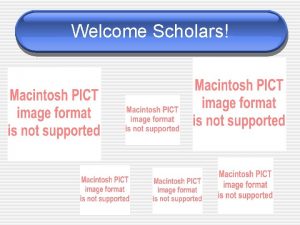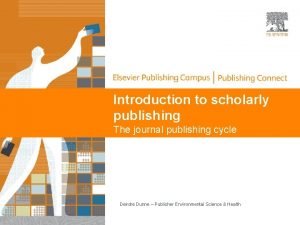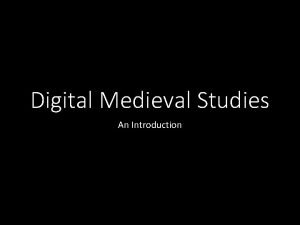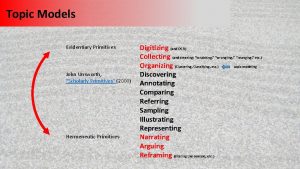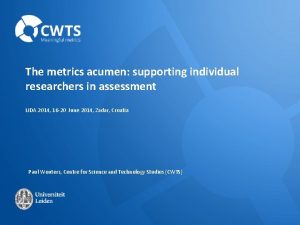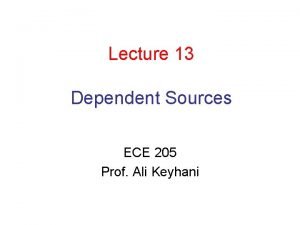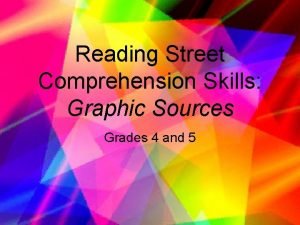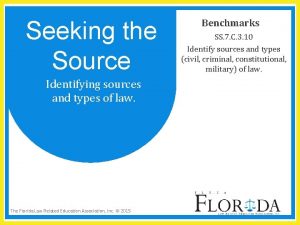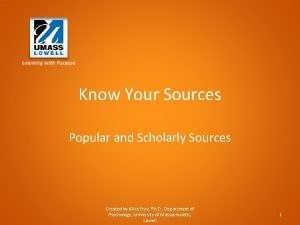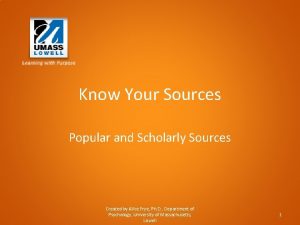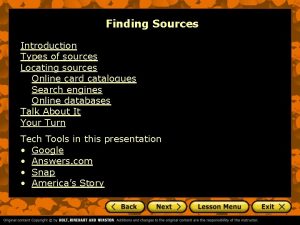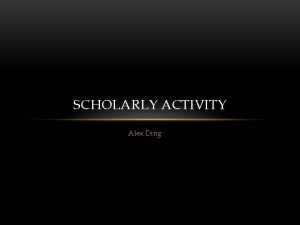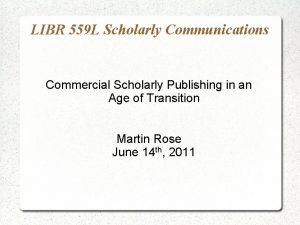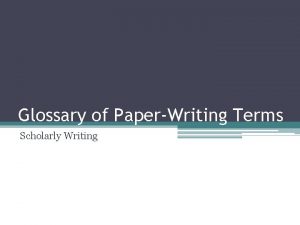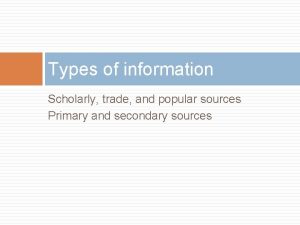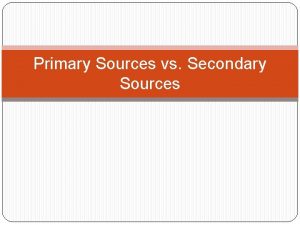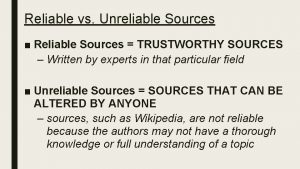TYPES OF SOURCES WHAT ARE SCHOLARLY SOURCES http




















- Slides: 20

TYPES OF SOURCES

WHAT ARE SCHOLARLY SOURCES? http: //vimeo. com/27119325

SCHOLARLY SOURCES Sources written by experts in a field § Can be a book or an article

PEER-REVIEWED SOURCE An article that has been reviewed by several experts in the field who all agree that the information is valid and legitimate.

SUBSTANTIVE SOURCES � Written for an educated, but not necessarily expert, audience. They seldom claim to present new knowledge; instead, they make knowledge available to non-experts. � They often cite scholarly sources, but generally do not include a bibliography. Authors need not be scholars in the field; however, they engage in significant research and support their claims with reasons/subclaims and evidence Examples: Time Magazine, Harpers, The Atlantic, Psychology Today, Scientific America, a U. S. Government Report and many, many more!

SUBSTANTIVE SOURCES Not every article in these magazines is substantive. Usually just the feature/cover article. For a list of substantive sources, click the link & scroll down to magazines http: //www. aldaily. com/

WHAT ARE PRIMARY SOURCES? Primary Source Document or physical object which was written or created during the time under study. � These sources were present during an experience or time period and offer an inside view of a particular event � The term “Primary Source” means different things in different disciplines. In English or Art or History: � Diaries, speeches, novels, poems, manuscripts, letters, interviews, news film footage, autobiographies, official records, a piece of art, a song, map, speech, etc. In Social and Hard Sciences: � Published study that records the results of an experiment

WHAT ARE SECONDARY SOURCES? Secondary Sources define and analyze primary sources. In English or Art or History: A peer-reviewed article, analysis of a short story, review of a movie, interpretative article about a piece of art In Social Sciences and Hard Sciences: A magazine article about cancer, a psychology textbook, a book for kids about tribes in Africa.

WHAT ARE TERTIARY SOURCES? !!! You can NOT use any tertiary sources in unit 2 !!! Tertiary sources � A source that collects and distills information from primary and secondary sources � Often present a summary of information � Often condense info from primary & secondary sources Examples: Newspapers Encyclopedias Most Open (Free) Websites: like a business’s website or info from the website for a non-profit organization, personal websites, blogs, etc.

EXCEPTIONS REGARDING WEBSITES The term “website” is highly problematic! There a few types of “websites” that are credible and house scholarly work that you CAN use in unit 2. � Peer-Reviewed Open-Access Journals: Journals that provide free access to ALL users via the internet Journal of Art Historiography � VCU Library Databases (library databases are NOT free and open)

POP QUIZ! 1. You are writing a report about the Holocaust and you are looking at letters written by a women while in a concentration camp. What kind of source is this? Primary, Secondary, Scholarly, Substantive, Peer-Reviewed, Tertiary

POP QUIZ! 2. You are writing a paper about depictions of women in Disney Movies. You watch Snow White and the Seven Dwarves. What kind of source is the movie? Primary, Secondary, Scholarly, Substantive, Peer-Reviewed, Tertiary

POP QUIZ! 3. You are studying the way that Fox News discusses the death penalty. You watch Fox News reports on TV to see for yourself. What kind of source is this? Primary, Secondary, Scholarly, Substantive, Peer-Reviewed, Tertiary

4. You are writing a paper about crime in Richmond, VA. You see a show on CNN discussing this exact topic, and there are some great statistics you want to cite. What kind of source is this? Primary, Secondary, Scholarly, Substantive, Peer-Reviewed, Tertiary

POP QUIZ! You are studying the way police are depicted in Law and Order. You find a great article about this exact topic in The New York Times. What kind of source is this? 5. Primary, Scholarly, Substantive, Peer Reviewed, Tertiary

POP QUIZ! 6. You are studying the way police are depicted in Law and Order. You find a great article written by an expert about this exact topic in The Journal of Crime Television. What kind of source is this? Primary, Scholarly, Substantive, Peer Reviewed, Tertiary

7. You are studying the way police are depicted in Law and Order. You find an 8 -page feature article written by a professional, well-known journalist about this exact topic in Time Magazine. What kind of source is this? Primary, Scholarly, Substantive, Peer Reviewed, Tertiary

LAST QUESTION! 8. You are studying the way police are depicted in Law and Order. You find a great 8 -page feature article written by a professional, well-known journalist about this exact topic in the online version of Time Magazine. Primary, Scholarly, Substantive, Peer Reviewed, Tertiary

THINKING ABOUT SUMMARY IN YOUR SAS http: //vimeo. com/27119582

MOST COMMON MISTAKES IN SAS Citations— indent all lines AFTER first In-text citations for the quote section Placement of period � APA “for the rest of her life” (Smith, 2009, p. 19). Smith (2009) said, “…for the rest of her life” (p. 19). � MLA “for the rest of her life” (Smith 19). Smith said, “…for the rest of her life” (19).
 Insidan region jh
Insidan region jh Scholarly habits
Scholarly habits Scholar advanced search engine
Scholar advanced search engine Scholarly tutoring
Scholarly tutoring Pmp communication model
Pmp communication model Scholarly publishing and academic resources coalition
Scholarly publishing and academic resources coalition Scholarly articles
Scholarly articles Scholarly
Scholarly Scholarly primitives
Scholarly primitives Scholarly acumen
Scholarly acumen Madeleine leininger scholarly articles
Madeleine leininger scholarly articles Csun scholarly articles
Csun scholarly articles Print sources and web sources
Print sources and web sources Water resource
Water resource Http //mbs.meb.gov.tr/ http //www.alantercihleri.com
Http //mbs.meb.gov.tr/ http //www.alantercihleri.com Siat.ung.ac.id krs
Siat.ung.ac.id krs 4 types of dependent sources
4 types of dependent sources Sources of graphics
Sources of graphics Http://types of law
Http://types of law Resolving power equation
Resolving power equation Sources and uses of funds
Sources and uses of funds

